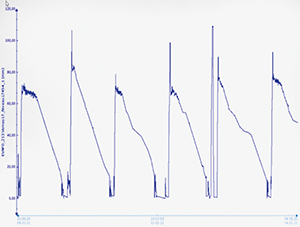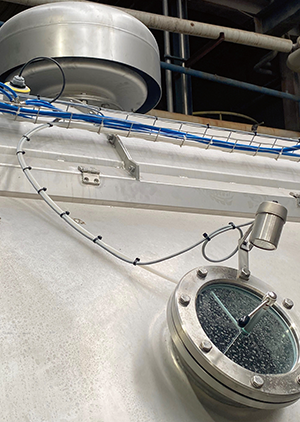
The operators of the Belgian company Cosucra cannot complain of boredom – their production processes are extremely diverse, beginning in the field and ending in the clean room. This means they have to deal with everything from sand-contaminated raw materials to the strict hygiene guidelines of EC 1935/2004. Throughout all this, the VEGAPULS C 21 keeps its cool. The radar sensor adapts easily to the wide variety of requirements and delivers reliable measuring results unaffected by the ambient conditions.
Cosucra was founded in 1852 in Warcoing, in the Walloon region of Picardy, and was originally involved in sugar production. Over the last 20 years, the group has undergone a profound transformation and become a leader in the production of plant-based natural ingredients. Derived from chicory and peas, its products supply food and nutritional health markets worldwide.

The production process starts in the fields where chicory and peas grow. These two crops go through multiple stages of processing before they are sold as finished products all over the world. The raw materials, to which initially a lot of sand and dirt adhere, are processed in total compliance with hygiene regulations. Under these conditions, the VEGAPULS C 21 ensures the proper functioning of a key element in the process: the rotating filter. The radar sensor adapts to all requirements and operates trouble-free, delivering a steady flow of reliable measuring results. Cosucra’s process for the production of inulin, the fibre of the chicory root, fulfils the requirements of EC 1935/2004 or EHEDG.
All the good things are so close
Ever since its founding, Cosucra has been committed to handling raw materials with great care and optimising its energy efficiency. For example, the harvested peas and chicory grow practically on the company’s own doorstep. The new pea protein production line was also designed with the environment in mind, just like many other components of the plant – from the wastewater treatment facility, to the high-performance filters, to the use of locally produced biogas.
Valuable ingredients
Peas contain up to 25% protein content and many amino acids, and their cell-wall fibre is a natural, functional component of dietary fibre. Chicory, also called coffeeweed, comes in two varieties: the one is used for its leaves, as in salads (leaf chicory), and the other for its root and the products made from it (root chicory).
The root consists mainly of water, pulp and insoluble sugars, and contains about 16% inulin. Inulin is a natural dietary fibre used in food production to improve texture and taste. It also offers many nutritional benefits. For example, inulin is used as a starch substitute in the treatment of diabetes mellitus.

From the field to the clean room
The first steps in the extraction of inulin are very similar to the processing of sugar beets. Inulin is similarly extracted via a gentle process using hot water. This concentrated liquid solution from the chicory root is then further processed into dietary fibre in liquid or powder form.
“Our production site actually has every kind of challenging environment you can think of. The processes are either outdoors or in the clean room, dusty or aggressive. We have processes that operate under positive pressure or negative pressure. In some processes we have to deal with strong vibration or an ATEX environment,” explains Vincent Vercamst, maintenance manager in the electrical and instrumentation department at Cosucra, pointing out the main challenges in production. “Consequently, all measuring instruments must comply with the ATEX directive, but also with the specifications of EC1935/2004 or EHEDG.”
Hot processes require robust sensors
With measuring instruments like VEGASON, VEGACAP, VEGADIF, VEGABAR or VEGATOR, VEGA has been helping to ensure reliable production at the Warcoing plant for over 25 years now. “An unbeatable price/performance ratio, low maintenance, high long-term reliability and incredible robustness,” says Vercamst, as he summarises the reasons that tipped the scales in favour of VEGA’s sensors.
Released at the beginning of 2021, the VEGAPULS C 21 compact radar level transmitter is used in the production of inulin. This process is divided into the following processing steps: washing, grinding, filtering, evaporation, bagging and storage. Process temperatures of up to 90°C are typical.
Deployment in the rotary filter
The non-contact radar level sensor is ideal for simple applications where a high protection class is required. The filtration process is one of the typical applications that require the sensor to be highly sensitive and accurate, yet extremely robust at the same time. Here, a rotary filter rotates in a trough filled with water and sand, which is sucked up at the circumference of the filter with the help of a vacuum pump. The vacuum pump runs during the entire sand collection process. The trough is emptied and then filled again with product ready to be filtered. “In this way, the impurities in our products are filtered out by the sand,” explains Vercamst.
The VEGA sensor first measures the distance between the sensor and the empty filter – this is basically the zero point. During the filtration process, the VEGAPULS C 21 continuously measures the thickness of the sand layer on the outer side of the rotating filter. “We analyse the distance between the sensor and the rotary filter. With this data we can constantly check the sand thickness in the critical area. This is important for us, because the thickness of the sand layer influences the quality of the filtered product. In the past, we always had problems with sand stability, which resulted in high costs of around 8000 Euros each time. Now, thanks to the VEGA sensor, the filtration process can be controlled very precisely,” he says.
Radar replaces visual monitoring
The big advantage of the VEGAPULS C 21 is that it delivers exact measuring results without effect from the medium, or the process and ambient conditions. Besides the 80 GHz radar technology, it is mainly thanks to the optimised signal processing that the sensor is able to deliver reliable measured values virtually around the clock.
Due to the strong focusing enabled by the 80 GHz operating frequency, the radar beam can be aimed at the liquid surface with pinpoint accuracy. Interfering signals, for example caused by build-up on the antenna system, are simply blocked out. The sensor is also so small that it can be installed practically anywhere. This is an advantage that is especially appreciated at older production sites, which were not specifically designed to accommodate any level sensor technology.
Until recently, the filtration process in the chicory plant was usually monitored visually by the operators. “We had also tried lasers and ultrasonics, but these technologies left a lot to be desired in terms of reliability. Instruments from other manufacturers were also unable to cope with the demands of the process,” recalls Vercamst. Only the compact VEGAPULS C 21 was finally able to solve the problem, bringing accuracy, reliability and repeatability to the process.
Vercamst and his team were also impressed by its resistance to steam and splash water. They were able to install the new sensor very quickly thanks to Bluetooth and the intuitive adjustment structure. Bluetooth simplifies things like setup, displaying of readings and diagnostics, especially when the sensor is installed in a harsh environment, in an Ex area or at a measuring site that is difficult to access.
What is more, all relevant information about the VEGA instrument can be retrieved just by entering its serial number. This facilitates any later maintenance work. It is a concept that Vercamst has found very convincing and applicable to other measuring points: “In the meantime, we’ve been gradually replacing any unreliable sensors with VEGA instruments wherever possible.”
| Tel: | +27 11 795 3249 |
| Email: | [email protected] |
| www: | www.vega.com/en/home_za |
| Articles: | More information and articles about VEGA Controls SA |

© Technews Publishing (Pty) Ltd | All Rights Reserved